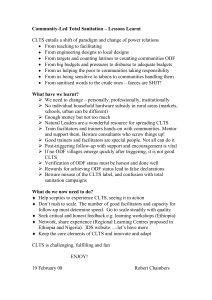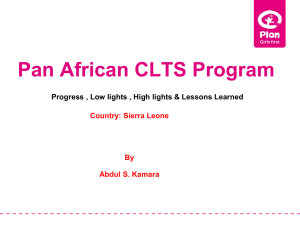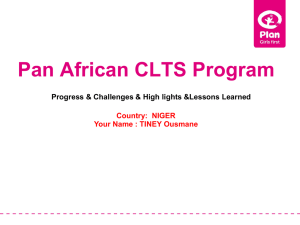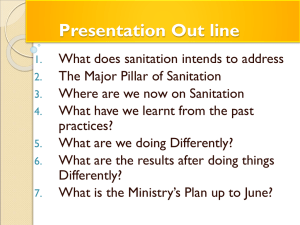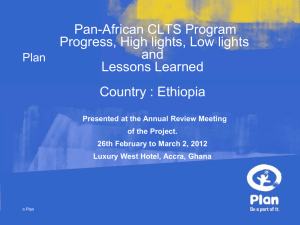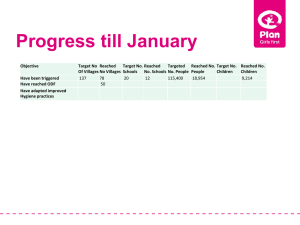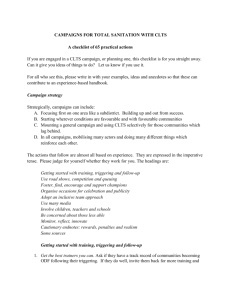Guidelines for Community-Led Total Sanitation
advertisement
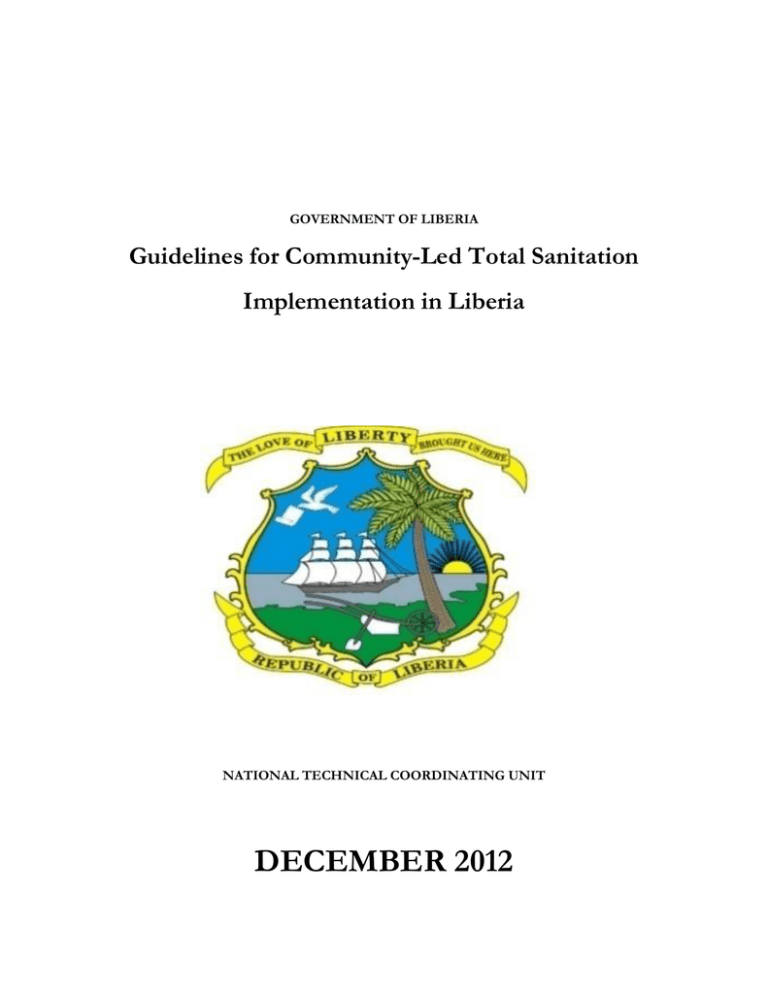
GOVERNMENT OF LIBERIA Guidelines for Community-Led Total Sanitation Implementation in Liberia STANDARD OPERATING PROCEDURE FOR NATIONAL TECHNICAL COORDINATING UNIT DECEMBER 2012 ACRONYMS AMCOW African Ministerial Council on Water and Sanitation CLTS Community- Led Total Sanitation CHF Cooperative Housing Foundation CSC County Steering Committee DCMHyP Directorate of Community Mobilization and Hygiene Promotion DEOH Division of Environmental and Occupational Health DSC District Steering Committee gCHVs General Community Health Volunteers GOL Government of Liberia IYS International Year of Sanitation MOE Ministry of Education MOHSW Ministry of Health and Social Welfare MIA Ministry of Internal Affairs MLME Ministry of Lands Mines and Energy MPW Ministry of Public Works NL Natural Leader NTCU National Technical Coordinating Unit NSC National Steering Committee NWSHPC National Water, Sanitation and Hygiene Promotion Committee NWSSP National Water Supply and Sanitation Policy OD Open Defecation ODF Open Defecation Free RWSSB Rural Water Supply and Sanitation Bureau SOM Sector Operating Matrix SSP Sector Strategic Plan TOT Training of Trainers WASH Water, Sanitation and Hygiene TABLE OF CONTENTS 1 2 Introduction ................................................................................................................................................................ 1 1.1 Background to Sanitation in Liberia .............................................................................................................. 1 1.2 Global Context.................................................................................................................................................. 2 1.3 Community-Led Total Sanitation .................................................................................................................. 4 1.4 History of Community-Led Total Sanitation in Liberia ............................................................................. 4 1.5 Guidelines for Community-Led Total Sanitation in Liberia...................................................................... 7 Institutional Structure of CLTS in Liberia ............................................................................................................. 8 2.1 National Level ................................................................................................................................................... 8 2.2 County Level ................................................................................................................................................... 10 2.3 District Level ................................................................................................................................................... 11 2.4 Community Level ........................................................................................................................................... 12 3 Requirements and Steps in CLTS Implementation ............................................................................................ 13 4 Capacity Development ............................................................................................................................................ 15 4.1 Orientation for Policy-Level Stakeholders ................................................................................................. 15 4.2 Training for Facilitators and Natural Leaders ............................................................................................ 17 5 Post-ODF Scale-Up ................................................................................................................................................ 18 6 Reporting and Documentation .............................................................................................................................. 20 7 Miscellaneous............................................................................................................................................................ 21 8 Annexes ..................................................................................................................................................................... 23 1 Introduction 1.1 Background to Sanitation in Liberia Sanitation interventions in Liberia have, until recently, received very little attention as compared with other development programs. This has been due, in part, to a lack of policy-level commitment, low institutional framework and poor program implementation. While water remains a more valued resource for community development, poor access to sanitation compromises gains made at increasing access to water supply. Recently though, there has been a push to move sanitation to the fore front. Research has shown the cost-effectiveness of sanitation and water supply, and their importance in improving health, advancing social development and protecting the environment. The Government of Liberia (GOL) developed its National Water Supply and Sanitation Policy (NWSSP) in 2009 and WASH Compact in 2011. The WASH Compact was developed with full support of the national legislature to accelerate the delivery of water, sanitation and hygiene services in the country. Both documents identify Community-Led Total Sanitation (CLTS) as a communityled approach to sanitation and hygiene promotion. Community involvement in water and sanitation interventions is crucial to the success of WASH programs and by extension to the prevention of WASH related diseases – diarrheal diseases, helminthes and skin infections. The commitment to implementing CLTS in Liberia is solidified in the Sector Operating Matrix (SOM) of the Sector Strategic Plan (SSP) for 2012-2017, which includes various commitments around CLTS. Building on the NWSSP, coupled with commitment by the President of the Republic of Liberia to sustainable WASH services as outlined in the Compact, sanitation interventions are now expected to receive greater attention than in the past. It is also expected that the Division of Environmental and Occupational Health (DEOH) at the Ministry of Health & Social Welfare (MOHSW) shall be elevated to a Directorate of Community Mobilization and Hygiene Promotion (DCMHyP) and charged with the responsibility for generating demand, community mobilization and hygiene promotion interventions. The directorate will provide dedicated support to the Rural Water Supply and Sanitation Bureau (RWSSB), a body that will be responsible for coordination and ensuring rural water supply and sanitation services with a focus on hardware. The RWSSB will be created by elevating the existing Rural Water Supply and Sanitation Program to the status of a bureau. 1 These guidelines are meant to offer structure and organization to the implementation of CLTS throughout Liberia. They deliver on a commitment made in the SSP SOM. This document is the first version of these guidelines, a work-in-progress to be updated as deemed necessary by the National Steering Committee. 1.2 Global Context The United Nations declared 2008 the International Year of Sanitation (IYS). As part of the IYS, the African Ministerial Council on Water and Sanitation (AMCOW) organized the second African Conference on Sanitation & Hygiene (AfricaSan+5) which recognized the scale of problems in subSaharan Africa and established key commitments to place sanitation and hygiene at the top of the development agenda in Africa. At the end of the conference the Ministers signed the eThekwini Declaration, in which they pledged to create separate budget lines for sanitation and hygiene in their countries and to commit at least 0.5 percent of GDP, among other commitments. Though Liberia did not sign the declaration, the GOL has embraced the eThekwini Declaration. The AfricaSan+5 followed the First AfricaSan Conference of 2002, which helped formulate Millennium Development Goal (MDG) 7: to reduce, by half, the number of people without access to basic sanitation and hygiene by 2015. The Third AfricaSan Conference took place in 2011 in Kigali, Rwanda. AMCOW again hosted this event from which came the Kigali Ministerial Statement on Sanitation and Hygiene. Liberia was represented by the Mayor of Monrovia. The commitments in the eThekwini and Kigali Declarations (see box below) have important areas for continuing policy advocacy and monitoring of progress towards these ambitious regional goals. Box 1. eThekwini Declaration and Kigali Ministerial Statement eThekwini Declaration Kigali Ministerial Statement 1. To support AMCOWS leadership on 1. Continuous advocacy and awareness to tracking the implementation of the sustain the sanitation momentum explicitly Declaration and prepare a detailed report on at the regional, national, sub-national and progress local levels in policy, budgetary allocation, 2. To established, review, update and adopt human resources and implementation. 2 national sanitation and hygiene policies; 2. Strengthen community efforts and develop establish one national plan for accelerating the capacities of local governments, NGOs, progress to meet sanitation goals and MDGS Youths, and Community Base Groups by 2015. (CBGs) to work in partnership for sanitation 3. To increase the profile of sanitation and hygiene in Poverty Reduction Strategy Papers. 4. To ensure one principle, accountable institution take clear leadership of the national sanitation portfolio; establish one sustainability. 3. Ensure occupational health, safety and dignity to improve the profile and working conditions of personnel involved in sanitation. 4. Priorities sanitation as a development coordinating body with specific intervention for health, security and dignity responsibility for sanitation and hygiene, of all members of communities, especially involving all stakeholders including but not infants, girl-children, women, the elderly, limited to relevant line ministries ( finance, and differently-abled people. health, water, education, gender and local government. 5. Mainstream sanitation across sectors, ministries/departments, institutions, 5. To establish specific public sector budget domains (private, household, schools, allocations for sanitation and hygiene, community, public) and social-political minimum of 0.5% of GDP. persuasions, so that sanitation becomes 6. Encourage effective and sustainable approaches such as household and every body’s concern. 6. Develop and implement approaches, community-led initiatives, marketing for methodologies, technologies and systems for behavior change, educational programs and emergencies and disaster situations, and for environmental caring, which make specific areas with special characteristics /terrains or impact upon the poor, women, children, groups suffering temporary displacement. youth, and the un-served. 7. Development information monitoring system and tools for tracking progress at all 7. Global advocacy for the recognition of climate change impacts on sanitation. 8. Encourage flexibility and variety in options levels, work with regional and global bodies, and practical solutions to suit local produce a report by 2010. conditions preferences and resources. 8. To recognize the gender and youth aspect of 9. Inter-country Working Group, led by 3 sanitation and hygiene, involved women in Country focal points, meet periodically to all decision-making levels so that policy, promote research and development, strategy and practice reflect gender sensitive collaborations, exchanges of innovations, approaches. experiences and expertise; networks among 9. Build and strengthen capacity of sanitation intra-country groups and agencies for implementers, support research, partnership development and knowledge exchange. sharing of knowledge. 10. Adopt the South Asia roadmap for 10. Give special attention to countries or areas emerging from conflict or natural disasters. developing National Action Plan to achieving sanitation goals. 1.3 Community-Led Total Sanitation CLTS is an innovative methodology for mobilizing communities to conduct their own appraisal and analysis of open defecation (OD), stimulating a collective sense of disgust and shame among community members as they confront the crude facts about mass OD and its negative impacts. The basic assumption is that no human being can stay unmoved once they have learned that they are ingesting other people’s feces. Communities generally react strongly and develop action plans to become open defecation free (ODF) through their own effort based on different motivations. CLTS focuses on behavior change, triggering the community’s desire for change and encouraging innovation, mutual support and appropriate local solutions, thus leading to greater ownership and sustainability. It accomplishes all of this without external subsidies. Facilitators and natural leaders enable this process, developed by Kamal Kar in Bangladesh around the year 2000 and now used in more than 25 countries. 1.4 History of Community-Led Total Sanitation in Liberia 1.4.1 Choosing CLTS for Liberia The GOL embraced CLTS for various reasons. One important reason was that it has shown success in sub-Saharan Africa, particularly in neighboring Sierra Leone. In addition, CLTS complements Liberia’s progression from a state of relief to development as external subsidies are not included in the methodology. It also complements Liberia’s policy on decentralization as county and district authorities are key to success, especially around monitoring. These, plus additional reasons for choosing CLTS for Liberia, are listed in the box below. 4 Box 2. Reasoning Around Choosing CLTS for Liberia × CLTS has shown success in sub-Saharan Africa, including Sierra Leone; × The methodology around CLTS complements Liberia’s progression from a state of relief to development; × The emphasis on county- and district-level engagement reflects the tenets of Liberia’s decentralization policy; × Using communities as an entry point has proven successful in sanitation and hygiene programs; × The lack of access to sanitation services adversely affects poor people and disadvantaged groups; × CLTS offers opportunities for involving both the public and private sector and can lead to partnerships; × Scaling up CLTS could help Liberia’s progress towards the MDGs, specifically MDG7. 1.4.2 Introduction of CLTS to Liberia During the first week of March 2009, UNICEF in collaboration with WaterAid, organized a CLTS workshop for five Anglophone West African countries, including Liberia, in Otukpo, Benue State, Nigeria. A total of sixty-one participants attended the workshop, facilitated by Dr. Kamal Kar and his colleague Professor Robert Chambers. The workshop promoted the CLTS approach and facilitated the development of action plans for introducing CLTS in all participating countries. As part of its action plan, the GOL invited Kamal Kar and Robert Chambers to Liberia to conduct a Training of Trainers (TOT) workshop at the end of the month. The TOT took place from March 30 – April 3, 2009 at Urey Farms in Careysburg, and targeted select GOL ministries and agencies and local and international NGOs. It brought on board many WASH partners, with an aim for building the human capacities and sharing experiences of other counties in relation to sanitation. The TOT resulted in the triggering of ten communities as a pilot in the Careysburg and Todee districts of Montserrado County. At the end of the workshop a National Steering Committee was set-up to be chaired by the Ministry of Public Works (MPW) and cochaired by MOHSW. 5 As a result of increased awareness brought about by the GOL to WASH programs, with support from UNICEF, WaterAid, CHF International, Concern Worldwide and Oxfam, a small-scale CLTS program was designed in Liberia in 2009. UNICEF funded the pilot, implemented by the GOL in partnership with local partners focusing on communities in Montserrado and Grand Cape Mount counties. Thirteen communities were triggered with all eventually becoming ODF. From 2009 onwards, CLTS has been implemented as a regular community initiative under the coordination of the National Steering Committee, with the National Technical Coordinating Unit providing support to partners. In July 2010, CHF International hosted an additional TOT in Monrovia, which led to the triggering of six communities. 1.4.3 The Re-Engineering Process & Beyond In 2011, MOHSW in collaboration with MPW and partners re-strategized to enhance the CLTS approach in Liberia due to the slow progress of the previous 2009-2010 CLTS strategy. This process, termed “re-engineering,” saw the involvement of GOL key line ministries - MOHSW, MPW, Ministry of Internal Affairs (MIA), Ministry of Lands Mines and Energy (MLME), Ministry of Education (MOE) - and other WASH stakeholders. The process was successful in promoting commitment to sanitation systems that lead to ownership and dignity and enhancing the partnership amongst stakeholders for implementation of participatory approaches to sanitation, effective advocacy and social mobilization. The sanitation sector in Liberia is gradually yielding increased community commitment and positive behavior change initiatives. Though still quite far from meeting sector strategic objectives for sanitation in Liberia, including a total of 5000 planned ODF communities, it is a positive sign of improvement through the CLTS approach. CLTS in Liberia has promoted innovativeness, confidence, and leadership skills of county authorities and emerging natural leaders. Community members have begun to build latrines on their own as a result of the promotional action implemented through the CLTS approach. The approach has also contributed to promoting child-friendly aspects and life skills-based hygiene education at household levels. Further, it has helped communities build ownership towards programs, analyze their sanitation problems and collectively solve problems. 6 It is expected that CLTS will further lead to a reduction in contamination of food and water, as well as reduced child mortality; increased economic growth; development of a healthy and productive human resource; sound environmental and occupational health; improved safety; increased community ownership of development agendas; scaling up of self-esteem; and promotion of social understanding and unified communities. 1.5 Guidelines for Community-Led Total Sanitation in Liberia Since its introduction to Liberia in 2009, CLTS has been implemented by a number of actors in an uncoordinated manner; partners have used different criteria for community selection and posttriggering monitoring has been weak in most instances. It is essential to avoid variations in community support and to maintain uniformity and standards in program implementation, which will in turn solve the problems of resource constraints and give an impetus to sanitation promotion. To make the program result-oriented, GOL and WASH partners have agreed to develop and adopt the guidelines contained herein as the standard for the country, to be adhered to by all partners implementing CLTS directly or indirectly throughout the Republic of Liberia. Full justification for the development of these guidelines can be found in Box 3 below. This document aims to achieve the following objectives for CLTS implementation in Liberia: × To set standards for the implementation of CLTS; × To enhance coordination and regulation of CLTS activities among stakeholders at all levels; and × To clearly define processes, procedures and practices for CLTS implementation in Liberia. Box 2. Justification for Liberia CLTS Guidelines × Lack of proper coordination among CLTS implementers at all levels; × Variation in CLTS implementation across partners (e.g. some partners are offering subsidized latrines in CLTS communities); × Lack of data on CLTS implementation from actors; × Untrained facilitators involved in the CLTS process; × Actors implementing CLTS without GOL recognition and approval; × Inappropriate monitoring of CLTS communities; × Lack of a post-ODF plan and exit strategy; × Insignificant number of ODF communities; × Adverse effects of lack of access to sanitation on poor people and disadvantage groups; × Promising opportunity for private sector engagement and partnerships; × Need to make progress on national and global development goals on water, sanitation and hygiene; and × Commitment to develop guidelines set forth in SSP SOM. 7 2 Institutional Structure of CLTS in Liberia The CLTS re-engineering process led to an institutional structure for CLTS in Liberia, led by the National Steering Committee (NSC). Management structures at national and county level have been established. Community management is handled mostly by general community health volunteers and natural leaders coming forth during the triggering process. There remains opportunity to strengthen institutional structures at all levels, especially district. The figure below shows the CLTS structural arrangement in Liberia as of December 2012. Figure 1. Structure of National CLTS Management in Liberia National Steering Committee (NSC) National Technical Coordinating Unit (NTCU) County Steering Committee (CSC) District Steering Committee (DSC) gCHVs Natural Leaders 2.1 National Level 2.1.1 National Steering Committee 2.1.1.1 Description This is the highest decision making body for CLTS in the country. 8 2.1.1.2 Composition Chair - Co-Chair - Ministry of Health & Social Welfare Ministry of Public Works Members: Ministry of Internal Affairs Ministry of Education Ministry of Information Ministry of Agriculture Ministry of Planning & Economic Affairs Monrovia City Corporation Civil Society Organizations Donors 2.1.1.3 Responsibilities × Mobilize resources for CLTS scale-up in Liberia; × Ensure the effective implementation of CLTS strategy in keeping with these guidelines and the Handook on CLTS by Kamal Kar; × Regulate the process of triggering, monitoring of ODF verification, declaration and certification; × Standardize and regulate training procedures and content for national partners; × Ensure documentation and sharing of CLTS best practices and lessons learnt, for policy decision-making and replication in other countries; × Ensure the establishment and regular update of a CLTS database; × Commission a national CLTS research initiative to determine the status in country; and × Meet once a month, or more often in case of emergency. × 2.1.2 National Technical Coordinating Unit 2.1.2.1 Description The National Technical Coordinating Unit (NTCU) will have a dedicated office within the DEOH of the MOHSW. Designated staffs of four (4) people (2 each from MOHSW & MPW) will be stationed in the NTCU to provide support to partners as well as manage CLTS implementation in 9 Liberia. The NTCU will provide briefings to the NSC and support county-level steering committees in CLTS coordination and management. 2.1.2.2 Composition Chair - Co-Chair - Ministry of Health & Social Welfare Ministry of Public Works 2.1.2.3 Responsibilities × Coordinate all CLTS activities in Liberia; × Set-up and manage CLTS database; × Report to the National Water, Sanitation and Hygiene Promotion Committee (NWSHPC) on a monthly basis; × Document best practices and lessons learnt on CLTS in Liberia; × Conduct CLTS research in collaboration with stakeholders; × Attend national and international CLTS seminar and fora; × Lead the process of developing and reviewing guidelines on CLTS; × Ensure strict adherence to these guidelines and the Handbook on CLTS by all stakeholders; × Validate all in-country CLTS training in consultation with the NSC; × Organize quarterly review meetings; × Conduct regular monitoring and monthly meetings; × Plan and conduct periodic monitoring of CLTS in Liberia in consultation with the NSC; × Perform other duties and tasks as assigned by the NSC; and × Validate ODF status of and provide certification to communities. 2.2 County Level 2.2.1 CLTS County Steering Committee 2.2.1.1 Description The County Steering Committee is the highest decision making body at county level; its role is to support communities in every aspect of the sanitation ladder in pursuit of achieving the MDGs. 10 2.2.1.2 Composition Chair - Co-Chair - Ministry of Health & Social Welfare Ministry of Public Works Members: Ministry of Internal Affairs Ministry of Education NGO Representation Community-Based Organizations 2.2.1.3 Responsibilities × Conduct assessment and mapping for proper targeting of communities for intervention; × Assign areas to development partners; × Identify core staff and non-staff to be trained and serve as resource center group; × Identify and train emerging and active natural leaders to support self and neighboring community to maintain an improved ODF status; × Collect data and share all CLTS information at county level; × Submit monthly reports to NTCU and share copies with WASH stakeholders; × Carry out CLTS verification in collaboration with NTCU; × Monitor and supervise CLTS activities at community level using approved forms; × Develop CLTS county plans and meet twice a month at county level; × Work along with community structure in place; and × Perform other duties and tasks as assigned by the NTCU. 2.3 District Level The role of district level stakeholders is vital to the success of the CLTS program. Results can hence be achieved through identification and mobilization of district level stakeholders, establishment and maintenance of effective coordination mechanisms, mobilization of available resources, and capacity development initiatives. 11 2.4 Community Level Stakeholders at this level form Community Development committees. CLTS recognizes communities as an entry point for sanitation and hygiene promotion, so all community members should be oriented and trained to be able to identify and exercise their full rights, roles and responsibilities, including mobilizing resources, coordinating with other community members, and promoting action or mutual help. The capacity development of sanitation volunteers, known as general Community Health Volunteers (gCHVs), and natural leaders, women groups, user committees, social mobilizers, local leaders, etc., also holds significance in keeping community commitment for action at all phases of the project. These individuals can be inspired through exposure and visits to nearby programs or projects, returning with enthusiasm and ideas for action. 12 3 Requirements and Steps in CLTS Implementation 3.1 Requirements for Implementers The NTCU has devised the following list of requirements for those partners wishing to implement CLTS in Liberia. Partners must × Be registered and accredited by the GOL (MOHSW and MPW); × Apply to the NTCU and be granted a permit to implement CLTS in Liberia; × Have at least 3 trained CLTS facilitators or be willing to go through the training by the NTCU; and × Have a functional office in the county of interest. 3.2 Steps in CLTS Implementation The general steps for CLTS implementation are below. For additional idea of what activities to include along the way, refer to Annex 1. Step I. Conduct county-level consultative meeting with CSC, County and district authorities: The implementing partner is required to support the NTCU to hold a consultative meeting with the CSC, county and district authorities. The meeting should focus on the details of CLTS implementation and role of county officials in the project. Step II: Support CSC (county facilitators) to train natural leaders using approved manual: The CSC is the highest decision making body for CLTS at the county level. Implementing agencies should support NTCU to train a team of facilitators who will lead the triggering exercise. Step III: Liaise with CSC to identify target communities (pre-triggering): It is strongly recommended that criteria (see Box 4 below) for community selection for CLTS implementation is followed. The implementing partner should also ensure that they visit communities to determine feasibility given their logistics. Step IV: Mobilize and work with county-level facilitators for community triggering. Step V: Conduct community triggering exercises in line with the CLTS Handbook: It is strongly recommended that the principles and approaches in Kamal Kar’s CLTS Handbook are strictly followed. Refer to Annex 2 for an in-depth look at triggering. Step VI: Conduct regular monitoring for community ODF and link with CSC in applying for ODF status to NTCU: Monitoring of CLTS communities should 13 adapt the natural leaders’ model. There should also be support to CSCs to monitor communities at least once a week. Step VII: Conduct celebration session for qualifying communities upon NTCU validation: Celebration of CLTS communities is based on a declaration by the NTCU. All ODF celebration sessions should provide sanitation start-up kits for communities. The sanitation kit includes but is not limited to: shovels; rakes; wheel barrows; hoes, whippers; cutlasses; and pingalins. Box 4. Criteria for Community Selection for CLTS in Liberia × Frequent occurrence of Acute Watery Diarrhea, cholera, typhoid, hepatitis, scabies, etc. over a six-month period; × Open defecation practiced in the community; × Presence of overgrown grass, misused latrines with uncovered pits, flies, bad odor and animal droppings; × Communities where there has been no NGO-subsidized sanitation program within 1 year; × Communities that are not benefitting from emergency interventions; × Communities that are requesting CLTS intervention; and × Smaller communities, between 10-50 houses, with a homogenous population and very close family and kinship ties (though implementation in bigger communities, above 50 houses, can follow). 14 4 Capacity Development Capacity development of stakeholders through orientation programs and trainings, a number of which have occurred, enable planning and monitoring. This package spells out the various components of the orientation of policy-level stakeholders. Basic information on training is included; a subsequent version of these guidelines will incorporate additional detail. Refer to Annex 3 for an example of budget line items for relevant trainings and other CLTS components. 4.1 Orientation for Policy-Level Stakeholders 4.1.1 Objective The objective is to create awareness for the policy stakeholders about the concept, objective and strategies of CLTS and ensure support in all aspects. 4.1.2 Expected Outcomes × Participants learn and understand the concept, objectives and strategies. × Policy-level commitments will be sought to support planning, implementation and monitoring. 4.1.3 Contents × Sanitation in Liberia – status, challenges and efforts; × Package for sanitation promotion centers; × Concepts and strategies of CLTS; × Step-by- step activities and Participatory Rural Appraisal tools; × Experience sharing and lessons learnt; × Roles and responsibilities of stakeholders; and × Commitment of partners and end users. 4.1.4 Format Duration: one (1) day Location: regional, county, district and clan-level meeting points 15 Methods: × Power Point presentation (overhead projector); × Group discussion; × Group work; × Distribution of Information, Education and Communication materials (e.g. CLTS guidelines, videos, brochures, etc.) and × Observation visits. 4.1.5 Resource Persons × trained government staff (national facilitators); × technical experts; × NGOs; and × support staff. 4.1.6 Participants × member organizations; × government ministries/agencies; × faith-based institutions; and × other policy-level stakeholders such as planning/development officers, school health sections/teachers, overseers, women workers, water/ sewerage officials, general community health volunteers, and WASH reporters. 4.1.7 Report Preparation/Follow-up The program organizers will prepare a report by detailing the above headings and take responsibility to follow-up on the activities. 16 4.2 Training of Leaders and Masons 4.2.1 Facilitators 4.2.1.1 National Facilitators National facilitators have been trained in Liberia and a database on these facilitators will be maintained by NTCU. Training of national facilitators is to be commissioned by the NSC or NTCU. For quality purposes, such national facilitators training should be conducted by internationallyaccredited CLTS trainers. 4.2.1.2 County Facilitators County-level facilitator training should follow key concepts and approaches as stated in the CLTS Handbook and should run for at least five (5) days. Participants should include representatives from MOHSW, MPW, MIA, MOE and WASH implementing partners. 4.2.1.3 Natural leaders Natural leaders training sessions usually run for at least three (3) days. The Liberia Natural Leader Training Manual is the official document to be used for all trainings targeting community members as natural leaders. Key aspects of the training include × Use of participatory approaches; × Use of pictures and visual aids; × Simulation; and × Field visits/exchange visits. 4.2.1.4 Masons Though optional, capacity development of local masons for latrine promotion can be beneficial; it can lead to effectiveness in construction supervision and monitoring, and contribute to upgrades in water and sanitation facilities and rebuilding of damaged ones. 17 5 Post-ODF Scale-Up I. Set up natural leaders network through the CSC Structure Through facilitation, implementers should encourage natural leaders to form a network which should be able to meet regularly. The network serves as a forum where natural leaders share experiences and find solutions to challenges encountered in scaling up sanitation. Motivation packages (in-kind) should be provided to natural leaders who help communities achieve ODF status. II. Sanitation marketing center: Sanitation marketing centers are meant to support communities in accessing sanitation hardware materials during the CLTS scale-up process. In districts where CLTS is being implemented, appropriate outlets (hardware stores, shops, construction companies, etc.) should be assessed and mobilized to be used as centers for sanitation marketing. Local communities should be linked to these entities through the natural leaders’ network. The NTCU will mobilize resources to ensure that sanitation marketing centers are established in CLTS districts in Liberia. Key sanitation material to be available at these centers includes, but is not limited to × Sand plats; × Handwashing stations; × Chemicals to treat termites (e.g Carbolyn); × Commodes; × PVC pipes; × Roofing sheets; × Steel bars; and × Water purification materials. III. Introduce PHAST in CLTS/ODF Communities Participatory Hygiene and Sanitation Transformation (PHAST) is an approach introduced in Liberia in 2006 to enhance community hygiene and sanitation. The approach is suitable for scaling up sanitation and hygiene, particularly when communities have reached ODF status. The use of PHAST should be directed only to communities where CLTS have been introduced and those that have reached ODF. 18 IV. Providing other WASH support to ODF Communities The NTCU will ensure that communities that have achieved ODF status are given priority in terms of WASH interventions. Such interventions to be directed in communities include × Provision of improved water sources; × Provision of better hygiene services; × Linking the community with the health system (e.g. malaria prevention through bed net distribution); and × Provision of support in linking communities to sanitation marketing centers. V. Enforcing Public Health Law The Liberia Public Health Law (1976) states that all dwelling places and public buildings should have adequate toilet facilities and all surroundings of dwelling places should be kept sanitary at all times. In support of ODF communities the NTCU will ensure, through the MOHSW structures, that communities are monitored periodically; where appropriate community members who fail to maintain the sanitary status of the homes will be taken to task in line with the Public Health Law. 19 6 Reporting and Documentation CLTS implementation should be followed by detailed reporting and documentation. Key information on triggering including the following should be documented by all implementing agencies: × Name of organization conducting triggering; × Name of community triggered; × Dates of triggering; × Community ODF plan stating households that commit to constructing latrines and expected dates of becoming ODF; × Population of the community; × CLTS tools used in triggering; and × Number of households. Reports on triggering should be submitted to the NTCU at least 10 days after triggering. Monthly monitoring reports should be submitted to the CSC and copies sent to the NTCU on or before the 25th of every month. The national CLTS database will be housed and operated at the NTCU and subsequently incorporated into the WASH sector database. Approved forms can be found in Annex 4. 20 7 Miscellaneous 7.1 Advocacy and Awareness Activities on advocacy and awareness have strongly motivated communities to promote hygiene and sanitation collectively. CLTS recognizes theses aspects as strategic tools to motivate them for achieving ODF status. Children are key players when it comes to sanitation and behavior change; they can be used to acquire messages and pass them on to their peers and other persons who may not be direct beneficiaries. These tools help ensure the consent and cooperation of the stakeholders working with central, district and community levels for sensitizing, igniting and mobilizing the communities for action. Local-level entrepreneurs should be encouraged to establish and promote sanitation marketing or resource centers in the community and provide technical advice, information and materials. The use of national advocacy structures such as the WASH Reporters and Editors Network, community radio stations, school health clubs, natural leaders; network, etc. is encouraged in the quest to create public awareness on the importance of community action for total sanitation. 7.2 Resource Mobilization Experience has shown that a subsidy provided for latrine construction usually hinders a community’s sense of ownership, dampens their zeal and enthusiasm for action and creates longterm dependency. As a result, communities often do not take initiative for better sanitation including latrine construction, but rather rely on external support. CLTS adopts tools to trigger communities to construct their own latrines and assist others, such as the marginalized, elderly or other vulnerable groups (e.g. physically challenged). For this, communities should adopt innovative and creative ways to effectively facilitate and support each other, especially the natural leaders, in the mobilization of local resources which will address the prevailing resource constraints, thus scaling up latrine construction in communities. Individuals and community-based organizations and institutions will be rewarded through recognition of their contributions by the national coordinating body, for making their communities and neighboring communities ODF. This practice of rewarding and recognizing communities will inspire them for further action. 21 Box 5: Justification for Not Using Household Subsidy for Latrine Construction × Subsidies do not address problems of landless people; × Subsidies do not cover the total cost of latrine (e.g. maintenance and use); × There is no guarantee for sustainability of sanitation improvements at community level without communities taking responsibility for their own sanitation improvement; × Subsidies dampen the feeling of ownership while furthering dependency; × Better-off people wait and do not construct latrines with the expectation that if they wait long enough, they will be given a subsidy for latrine construction; × Cost for constructing latrines for every household is too high for 100% coverage and there are limited resources to manage such cost; and × Experience shows that subsidies allocated for poor people has been overtaken by socially well-to-do and influential persons. 7.3 Humanitarian Situation and CLTS Access to sanitation remains a challenge in emergency situations. Wars and natural disasters damage sanitation infrastructure thus leaving the population without proper facilities for disposal of human waste. In such situations, people are forced to practice open defecation, even in streams which could be used as sources of water supply in such emergencies. The privacy and protection of women and children are normally compromised and there is potential for outbreaks of diarrheal diseases. The urgent nature of emergencies often leads to handouts from agencies through their donors to provide much needed services. Resultant facilities are mostly of inferior quality with no operation and maintenance systems. Such humanitarian situations have built dependency among refugee population and host communities, who also benefit either directly or indirectly from such interventions, with a corresponding challenge to the participatory approach to sanitation. While CLTS has been a challenge in emergency and some post-emergency situations, it can be successful if implemented through a phased approach. This way, communities are initially mobilized to contribute to some aspects of the latrine construction. An example would be having communities contribute to labor at the first phase and later increasing community responsibility for construction of superstructures, with NGOs providing some subsidy and later sensitizing communities to construct latrines without subsidies. 22 8 Annexes 8.1 Annex 1: CLTS Implementation Activities First Phase: Community Selection and Preparedness × × × × × × × Formation and reformation Orientation Partners application to NTCU Application received and screened Orientation of INGO/NGO Feasibility study of community/school/report Selection of community by CSC × Pre-triggering/notification to county/community/school County level trainings Formation of child-to-child sanitation club and sub-committee Orientation of child-to-child and subcommittee members × × × Second Phase: Sequential Flow Triggering and Action × × × × × × × × Introduction Ignition PRA Tools: 1. Walk of shame 4. Feces Calculation 2. Sanitation mapping 5. Medical Expense Calculation 3. Defecation mobility 6. Flagging Preparation of community plan of action and identify areas for training Community and school activities /resource mobilization/start of stopping open defecation Hands washing facilities, dish racks and cloths lines constructed and in use Family share latrines under construction Completion of temporary latrine and their use First announced verification /report Sanitation and hygiene checklist developed Third Phase: Follow Up Community: × × × × × × × Regular use of latrines by all Rebuilding of collapsed latrine Upgrading of latrines No Open Defecation continues Refresher training Follow-up and monitoring First announcement of ODF recognition with awards and certificates School: × × × × × Regular use and maintenance of latrines Garbage put under control and campus clean Follow-up monitoring and evaluation continues Child-child sanitation clubs establish Refresher training 23 8.2 Annex 2. Triggering Activities Ignition (Triggering) and Participatory Rural Appraisal Tools Ignition tools empower the communities in many ways by enhancing their knowledge and transforming behaviors. The use of the tools encourages discussion among community members to stop OD. As a result, they are spontaneously united to instantly develop a plan of action for formulation, implementation, monitoring and evaluation and follow-up of promotional actions. Walks of Praise and Shame Community people conduct a transect walk across the settlement to assess people’s defecation behavior and sanitation facilities, and identify hygiene and sanitation problems. Community people in the areas of OD will see their own shit, inhale the smell and feel ashamed. It’s important to spend time in the OD area asking questions while inhaling the unpleasant smell. Experiencing the disgusting sight and smell in this new way, accompanied by an outsider to the community, is a key factor in triggering mobilization, despite their embarrassment. People who practice OD are made shameful and aware of their behavior; this act in turn triggers community for seeking the immediate options to get rid of hazardous and shameful situation. Social Mapping Social mapping is an important ignition tool to promote sanitation after the walk of shame. Women and children groups help to facilitate the process, identify local level stakeholders by organizing the community to develop its plan of action based on local resources and launch-awareness raising activities for sanitation promotion. Defecation Mobility Map During this exercise, community people realize the fact that feces reaches water sources, vegetable fields, farm lands, foot trails, play grounds, public places, etc., and ultimately enters the mouth. The realization of such terrible facts sensitizes them to build and use latrines and stop OD as soon as possible. Triggering Disgust Ask for a glass or a cup of water, offer the water to some of the participants and ask them to drink, and after drinking say thanks to them. Next, pull a string of hair from your head and ask people to tell you what is in your hand then ask if they can see it. Touch it on some shit on the ground so they all can see. Now dip the hair in the glass of water and ask if they can see. 24 8.3 Annex 3. Example of Budget Line Items for Implementing CLTS at Community Level Budgeting will be done per the norms of the NTCU in collaboration with partners. However, the following budget template (unit cost per community) is being used in line with the WASH Sector Investment Plan for implementing CLTS in Liberia. Activity/item description Unit Quantity Frequency Unit Training of Natural Leaders Feeding Person 2 5 Days Transportation Reimbursement Person 2 2 Trips Lodging Person 2 6 Days Stationery (assorted) Bulk 2 1 Session DSA for National facilitators* Person 1 5 Days Venue rental* Person 2 5 Transportation Person 2 2 Trip Local DSA for staff Persons 2 1 Day Transportation (Local Vehicle rental) Vehicle 1 1 Day Triggering materials (assorted) Assorted 1 1 Session Packed lunch for participants* Persons 1 4 Fuel for National Facilitators* Gallons 20 1 Trip DSA for National facilitators Person 1 2 Days County/local level monitoring Person 1 18 days National level Monitoring Person 1 5 Days ODF Billboard Piece 1 1 Sanitation toolkit/materials Assorted 1 1 Bulk Feeding for participants Person 10 1 Meal Transportation Reimbursement Person 10 1 Trip Slabs Piece 10 1 Hand washing facility Piece 10 1 Bulk 1 1 Subtotal Pre-triggering visit Subtotal Triggering Subtotal Post-triggering Subtotal ODF Celebration Subtotal Sanitation social marketing Subtotal County level facilitator training 25 County level consultative meeting Bulk 1 1 Support to County Steering Committee Bulk 1 1 Grand Total 26 8.4 Annex 4. Monitoring Forms 8.4.1 CLTS Pre-Triggering Form CLTS PRE-TRIGGERING FORM 1. County: ______________________________________________________________________ 2. District: ______________________________________________________________________ 3. Clan: ________________________________________________________________________ 4. Community: __________________________________________________________________ 5. GPS Coordinates: X: _______________________ Y: ____________________________ 6. Name of Town Chief: ___________________________________________________________ 7. Number of Houses: ____________________________________________________________ 8. Number of Households (families): _________________________________________________ 9. Population: M: _________________ F: ______________Total: _______________ 10. Date of Pre-Triggering Visit: _____________________________________________________ 11. Names of Staff: _______________________________________________________________ _______________________________________________________________ 12. Name of Implementing Partner: _________________________________________________ 13. No. of Usable Latrines before CLTS: Household:_______________ Communal:____________ 14. Functional WASH Committee ___ YES ___ NO; If YES, M:____________ F:____________ 15. Before CLTS, No. of Dish Racks: ________________________________________________ 16. Before CLTS, No. of Clothes Lines:_______________________________________________ 17. Before CLTS, No. of Hand Pumps: _______ No. of Hand Pumps that are Functioning:_______ 18. Before CLTS, No. of Tippy-Taps/ Handwashing Facilities: _____________________________ 19. No. of Children 60 months (5 years old) and Below with Diarrhea in Last 2 Weeks: __________ 20. No. of Persons over 5 years old with Diarrhea in Last 1 Month: _________________________ 21. Proposed Date of Triggering:____________________________________________________ 27 8.4.2 CLTS Triggering Form CLTS TRIGGERING FORM 1. County: ______________________________________________________________________ 2. District: ______________________________________________________________________ 3. Clan: ________________________________________________________________________ 4. Community: __________________________________________________________________ 5. Population: M: _________________ F: ______________Total: _______________ 6. No. of Dwelling Houses:________________________________________________________ 7. No. of Family Latrines:___________ No. of Family Latrines that are Functioning:___________ 8. No. of Hand Pumps: ____________ No. of Hand Pumps that are Functioning: ____________ 9. Tools Used in Triggering (check all that were used): ______ Community Shit/ Pupu Mapping ______ Shit/ Pupu Calculation; If checked, No. of Bags:_______ ______ Calculation of Medical Expenses; If checked, Amount (LD):_________ ______ Walk of Shame ______ Transmission Route ______ Reflection 10. Attendance at Triggering: Adults:_____________ Children: __________ Total: ___________ 11. At What Stage (from Question #9) was Community Triggered? ________________________ 12. Result of Triggering: _________________________________________________________ 13. Proposed Date of ODF: ______________________________________________________ 14. No. of Family Heads Making Commitment to Build Their Family Latrines: _______________ List: NAME START DATE END DATE 15. No. of CLTS Latrines Community Promised to Build: _______________________________ 16. List of Natural Leaders: ______________________________________________________ ______________________________________________________ ______________________________________________________ 28 8.4.3 CLTS Weekly Monitoring Form CLTS WEEKLY MONITORING FORM 1. County: ______________________________________________________________________ 2. District: ______________________________________________________________________ 3. Clan: ________________________________________________________________________ 4. Community: __________________________________________________________________ 5. Name of Town Chief: ___________________________________________________________ 6. No. of Houses: ________________________________________________________________ 7. Date Triggered: _______________________________________________________________ 8. Implementing Partner: __________________________________________________________ 9. Names of Visiting Staff:_________________________________________________________ 10. Date of Last Visit: _____________________________________________________________ 11. Date of Current Visit: __________________________________________________________ 12. No of Latrines before Triggering: _________________________________________________ 13. No. of Latrines Started after Triggering: ____________________________________________ 14. No. of Latrines Completed After Triggering: ________________________________________ 15. Proposed Date of ODF: ________________________________________________________ 16. No. of New Diarrhea Cases in Children Under 5 Years Old for Past Week: M:___ F:___ Total: __ 17. No. of New Dish Racks Built: ____________________________________________________ 18. No. of New Clothes Lines Made: __________________________________________________ (Continued on Next Page) 29 # of H/H Served Latrine Complete d& In Use Y/N Soap/ Ash Water H/Washing Facility (Y/N) Present Squat Pit Cover (Y/N) Roof Superstruct ure (Y/N) Wall No. of Fam. M F Total No . Name of Household Head Slab made (Y/N) H/H Population New Pit Dug (Y/N) CLTS COMMUNITY WEEKLY MONITORING FORM (continued) 30 8.4.4 CLTS Monthly Monitoring Tool: Progressing Latrine Form CLTS MONTHLY MONITORING TOOL: PROGRESSING LATRINE FORM 1. County: ______________________________________________________________________ 2. Responsible Partner: ____________________________________________________________ 3. No. of Communities Triggered: ___________________________________________________ 4. No. of ODF Communities: ______________________________________________________ Soap Water # of H/Washing Facility Present In Use No. Latrines Complete Roof Superstructure Wall No. of slabs made Total F Name of Community M District No. Population No. of pits dug 5. Reporting Month/ Year: ________________________________________________________ 31 8.4.4.1 CLTS Monthly Monitoring Tool: Completed Latrine Form CLTS MONTHLY MONITORING TOOL: COMPLETED LATRINE FORM 1. County: ______________________________________________________________________ 2. Responsible Partner: ____________________________________________________________ 3. No. of Communities Triggered: ___________________________________________________ 4. No. of ODF Communities: ______________________________________________________ 32 ODF Status (Y/N) No. in Use Clothes lines No. Built No. in Use Tippy Taps No. Built No. In Use Dish Racks No. Built Total F M Beneficiaries No. of H/H Served No. of Houses Total Name of Community F No. M Population No.of Latrine completed 5. Reporting Month/ Year: ________________________________________________________ 8.4.5 Monthly Monitoring Tool: Natural Leaders Form CLTS NATURAL LEADERS FORM 1. County: ______________________________________________________________________ 2. District: ______________________________________________________________________ 3. Community: __________________________________________________________________ 4. Name of Town Chief: __________________________________________________________ 5. Monitoring Month/ Year: _______________________________________________________ 6. Town Chief Contact: __________________________________________________________ No. Name Position / Title Sex Age Contact Sign Effective Not Effective 33 8.4.5.1 CLTS Monthly Monitoring Tool: Diarrhea Monitoring Form CLTS MONTHLY MONITORING TOOL: DIARRHEA MONITORING FORM 1. County: ______________________________________________________________________ 2. Responsible Partner: ____________________________________________________________ 3. No. of Communities Triggered: ___________________________________________________ 4. No. of ODF Communities: ______________________________________________________ 5. Reporting Month/ Year: ________________________________________________________ Population No. District Name of Community M F Total Diarrhea Occurrences Children 60 months and below M F Total Persons above 5 years M F Total Total M F Total 34 8.4.5.2 CLTS CSC/ NTCU Monitoring Visit Form CLTS CSC/ NTCU MONITORING VISIT FORM Date: ______________________________________________________________________ Name Ministry/Division Position Community(ies) Visited Purpose Comment Sign Contact 35 8.5 Annex 5: ODF Certificate Template CERTIFICATE OF DECLARATION This is to certify that _______________________has been declared an Open Defecation Free (ODF) Town This CERTIFICATE OF DECLARATION is in recognition of their effort and hard work in making their town an Open Defecation Free Town. Given this _______________day of ______________AD____________________ ___________________________ MINISTER Ministry of Health and Social Welfare ______________________ MINISTER Ministry of Public Works 36 8.6 Annex 6: Standard ODF Billboard [MINISTRY OF HEALTH TOWN] IS AN OPEN DEFECATION FREE (ODF) TOWN “NO SCATTERING PUPU AROUND” OPEN DEFECATION IS NOT ALLOWED PLEASE USE THE TOILET, TOILET USE IS FREE Partner Logo GoL 37 8.7 Annex 7: ODF Celebration Sample Program TIME FRAME 0800-1100 1100 – 1110 1110 -1120 1120 – 1130 1130 – 1200 DESCRIPTION OF TASK FACILITATOR ARRIVAL OF GUESTS AND ODF COMMUNITIES OPENING PRAYER WELCOME STATEMENT OVERVIEW OF PROJECT & PRESENTATION OF ODF COMMUNITIES REMARKS PARTNER/GOL/ODF COMMUNITIES 1200 – 1220 CERTIFICATION OF ODF COMMUNITIES 1220-1240 RECOGNITION OF ODF TOWNS AND NATURAL LEADERS PRESENTATION OF SANITATION MATERIALS VOTE OF THANKS CLOSING PRAYER 1240 – 1300 1300 – 1310 1310 A COMMUNITY MEMBER THE COUNTY SUPERINTENDENT MOHSW WASH COORDINATOR/NTCU 1. ODF COMMUNITIES REPRESENTATIVE 2. COUNTY STEERING COMMITTEE 3. CHT 4. RESIDENT ENGINEER/MPW 5. PARTNER (IMPLEMENTING CLTS) 6. USAID 7. UNICEF 8. MIA 9. NATIONAL STEERING COMMITTEE ON CLTS 10. MPW 11. MOHSW MOHSW ASSIST. MIN/DCMO/PREVENTATIVE SERVICES CLTS IMPLEMENTING PARTNER MPW ASSIST. MINI/RURAL DEVELOPMENT/COMMUNITY SERVICES DISTRICT COMMISSIONER THE COMMUNITY MEMBER 38
